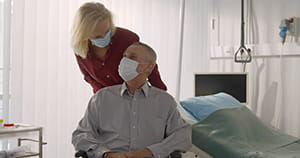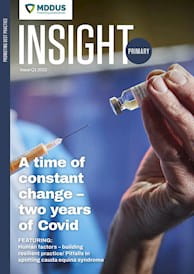
IT is well recognised that handover of patient care is a common area of risk, which is magnified when transferring between primary and secondary care services. Several factors contribute to this, including differing complex working systems, IT infrastructure that is not always well integrated, conflicting priorities and patient expectations – all of which have been exacerbated by the unprecedented demands and delays in care caused by the Covid-19 pandemic.
Addressing these issues can be challenging. NHS England, in liaison with other organisations such as the BMA and RCGP, has published key messages, and RCGP Scotland working with the BMA have produced principles, both designed to focus on the most effective and appropriate ways of working together.
The main risk is failure to transfer appropriate information, which can lead to patients receiving unsafe or delayed care, in addition to placing increased demands on clinicians’ time and contributing to patient frustrations. Resulting errors, for example in continuity of medication or failure in follow-up, can lead to complaints, claims, inquests and regulatory investigations.
A vital part in mitigating the risks is ensuring effective communication, which incorporates a mutual respect and understanding between clinicians as to the expertise, contributions and demands of each. All doctors have professional obligations to work collaboratively with colleagues and ensure they contribute to the safe handover of patients.
Effective written communication
When sharing information between primary and secondary care, it is important to keep in mind that the purpose is to ensure continuity of safe and appropriate care.
Good communication should:
- Be provided in a timely manner. Systems should be in place to ensure written communication is sent in an appropriate timeframe to reduce any interruptions to the patient’s care. Delays increase the risk of a patient receiving unsafe care (such as continuing a medication that has been stopped whilst an inpatient), as well as placing unnecessary demands on the system (for example, patients contacting services who do not have the information to address or act on their concerns).
- Be clear, relevant and accurate. For example, it is important that referral letters contain sufficient clinical information to allow determination of the urgency of the referral, and that they are specific in the expectations of the clinician and patient. We have seen examples where a lack of information has contributed to inappropriate downgrading of urgent referrals. It is also important that the language used is clear, and abbreviations that might not be understood by all are avoided. A recent MDDUS case involved hospital correspondence which contained an abbreviation specific to that organisation and led to a miscommunication about the urgency of a follow-up review.
- Highlight any changes to the patient’s care and actions required, ensuring this information is not hidden in the description of events. This is particularly important where there have been alterations to a patient's medications or further action is required, such as a review appointment. The rationale behind these should be included.
- Set out the line of responsibility for outstanding actions, such as chasing results of investigations or follow-up appointments. The interpretation of these results is usually most appropriately done by the person who requested the investigation and, in most circumstances, it is not appropriate to delegate this to another service without specific agreement. Clear information should be provided on how outstanding information will be communicated to patients.
Involving patients
- Moving between services. A key factor in reducing risk is ensuring patients are fully informed when moving between services. This includes being clear about the plan, timescales and who to contact should they have queries or further concerns. For example, when referring a patient to secondary care, they should understand the reason, urgency, expected timeframe and who to contact if they do not hear about an appointment, or if their symptoms change.
- On discharge. Patients should be made aware of any changes to their care, any outstanding actions, follow-up plans and who is taking responsibility for these, including how they will receive outstanding results, any actions they need to take and who to contact if they have concerns. Keeping patients fully informed is an effective means of reducing risk, giving them the knowledge and means to recognise and raise issues regarding their care.
- Capacity. Where patients lack capacity, it is important to ensure that those who care for them are provided with sufficient information. For all patients who may be more vulnerable (for example, because of mental health or cognitive difficulties, or who have multiple morbidities), it is important to consider whether additional follow-up is required, such as ensuring they attend review appointments and that they understand changes to their care.
Raising concerns
All clinicians are accountable for the information they provide. If you are unsure what you are being asked to do, or if you are not given sufficient time (for example, when completing a discharge summary on an unfamiliar patient), it is vital that you seek assistance from senior colleagues to ensure the information you provide does not compromise care.
The GMC sets out a doctor’s responsibilities in ensuring safe transfer of care. Where you have concerns about poor communication or unclear responsibilities between the services, you should take action to raise these in line with organisational policy.
The current unprecedented demands on clinicians’ time present challenges in effectively ensuring safe transfer of patient care, so clear communication between services – and between clinician and patient – is even more essential to ensure good clinical care and to reduce the risk of adverse events.
ACTION POINTS
- Take time when communicating with colleagues to ensure the information you provide is accurate and relevant.
- Make sure the most important points are clearly set out, including any changes or actions required.
- Keep patients fully informed.
- Raise concerns if you feel communications between services are contributing to risks in patient safety.
Dr Annabelle MacGregor, medical adviser, MDDUS
This page was correct at the time of publication. Any guidance is intended as general guidance for members only. If you are a member and need specific advice relating to your own circumstances, please contact one of our advisers.
Read more from this issue of Insight Primary

Save this article
Save this article to a list of favourite articles which members can access in their account.
Save to library

